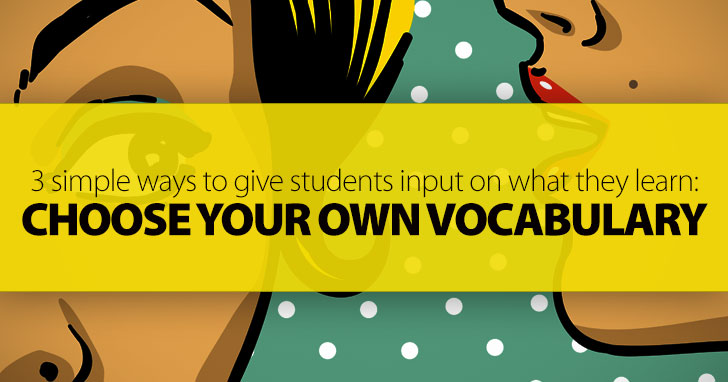Choose Your Own Vocabulary: 3 Simple Ways to Give Students Input on What They Learn


Are you looking for a new and engaging way to present new vocabulary to your English class? If you answer is yes, try this simple six-step process for getting new words into your students’ lexicons.

You may be following a curriculum, or you may have the freedom to choose your own material in your ESL classes. Either way, you can’t teach your students a new set of content vocabulary if you don’t first know what topic you want to cover. Teaching students new vocabulary centered around a theme makes it easier for their vocabulary learning efforts. So the first step in any vocabulary lesson should be to decide what theme your vocabulary will center around and then compile or review the specific vocabulary you want to teach.
Before introducing the new vocabulary to your students, see what they already know about the topic you have chosen. If you do, you will have a better understanding of what your students know and how well they will learn the material you will present. Will this vocabulary unit be a difficult one for them? Do they already have a strong foundation in this subject? In addition to informing you, bringing up what they already know will help them make mental links to new information. Think of the mind like a set of Lego blocks. New information is retained most easily when it is connected to information the learner already possesses.
To see what they already know, write the topic on the board, picnic for example. Then as a class, brainstorm all the words they already know associated with the topic. In this case, your students might offer words such as the following: summer, eat, kite, blanket, basket, food, fried chicken, potato salad, ants, etc.
Once you have gotten as many words on the board as your students can come up with, it’s time to sort them logically. You can either do this as a class or have small groups of students do the sorting. If you choose group work, have three or four students work together to group the words as they choose. Any organizational strategy will work as long as it is logical. In the picnic example, students might group food (fried chicken and potato salad), items to bring (blanket and basket) and activities to do there (eat and fly kites). Encourage students to fit all of the vocabulary into their organizational scheme if at all possible.
Once your students have grouped their words, it’s time to label the categories. Some students may have already given the groupings titles, but if they haven’t now is the time to do so. Then have students make a chart with a column for each categories they have. In my picnic example, I would make a chart with three columns and put the titles at the top of each column. Once they have their charts, students should list the words under the appropriate category.
After the titles are in place at the top of the chart and the words are listed underneath them, encourage your students to add any other words that come to their minds. You might encourage them to take each category and think about other items that would fit into it. As they come up with these words, they should add them to their charts.
Once they have run out of ideas, present to your class the new words that you have planned to teach. Your list may contain some of the words your students have already listed, or your list may be completely new. In either case, present new words to your students and explain their meanings. As you present the words, have your students add them in the appropriate columns. Note, because students have been working in groups, not every student will have the same categories on her paper. That is not important. What is important is students listing new words in their chart in logical places. If students find a word or two impossible to fit into their existing lists, have them add a column to their chart. Then have them brainstorm any other words they know that would fit into each new category they add.
Now that your students have brought out all their existing knowledge about your topic and you have added the new vocabulary you intended to teach, it’s time to put this vocabulary to use. You have as many options for assignments as days in the year, but here are some simple ways for your students to use their newfound vocabulary.
If you are tired of the traditional list of words and definitions when it comes to teaching new vocabulary, try this simple six step process. Your students will be more engaged and make better connections between what they are learning and what they already know, and you’ll feel good about how well they remember new vocabulary.
What themes do you cover in class?